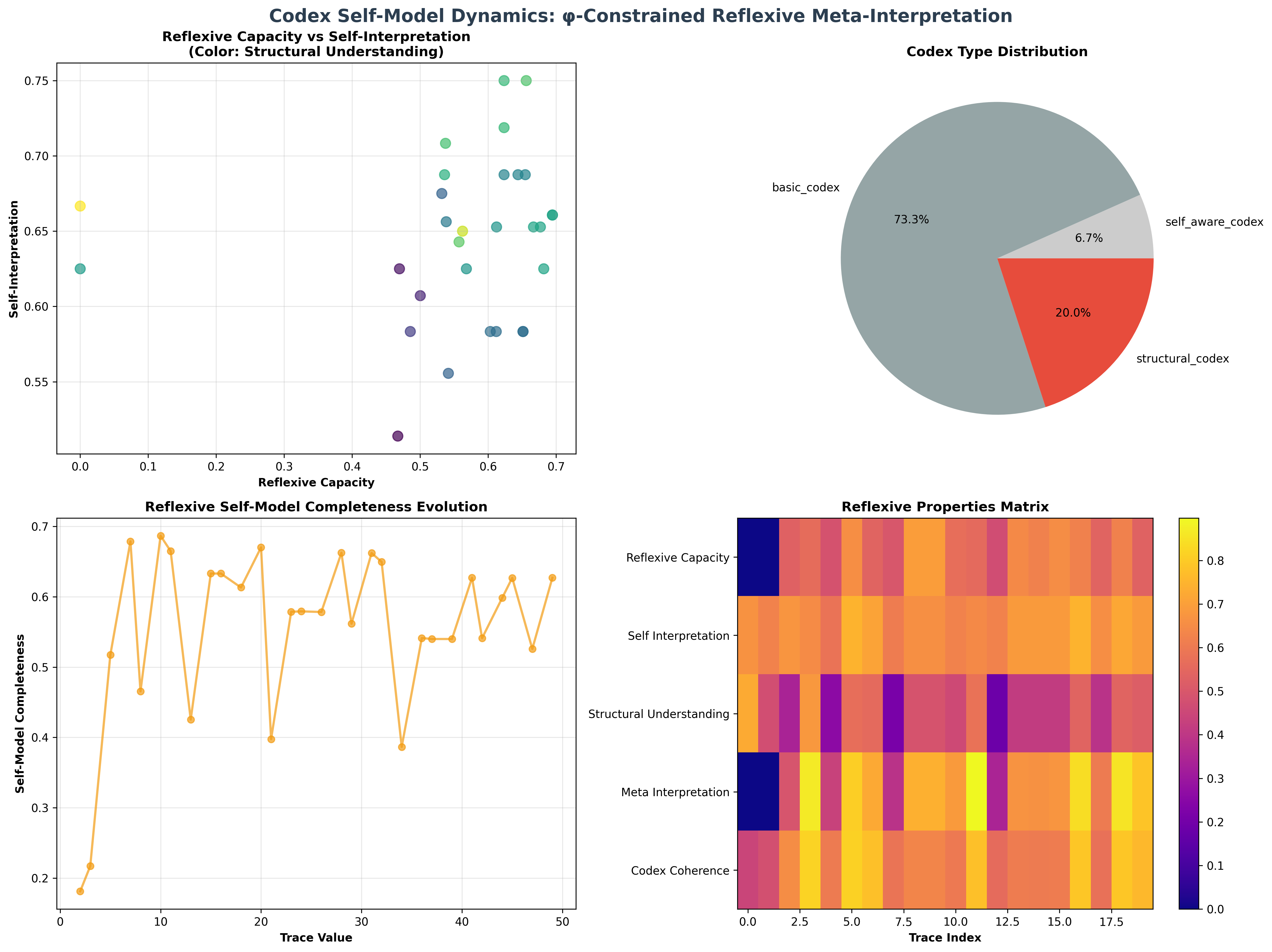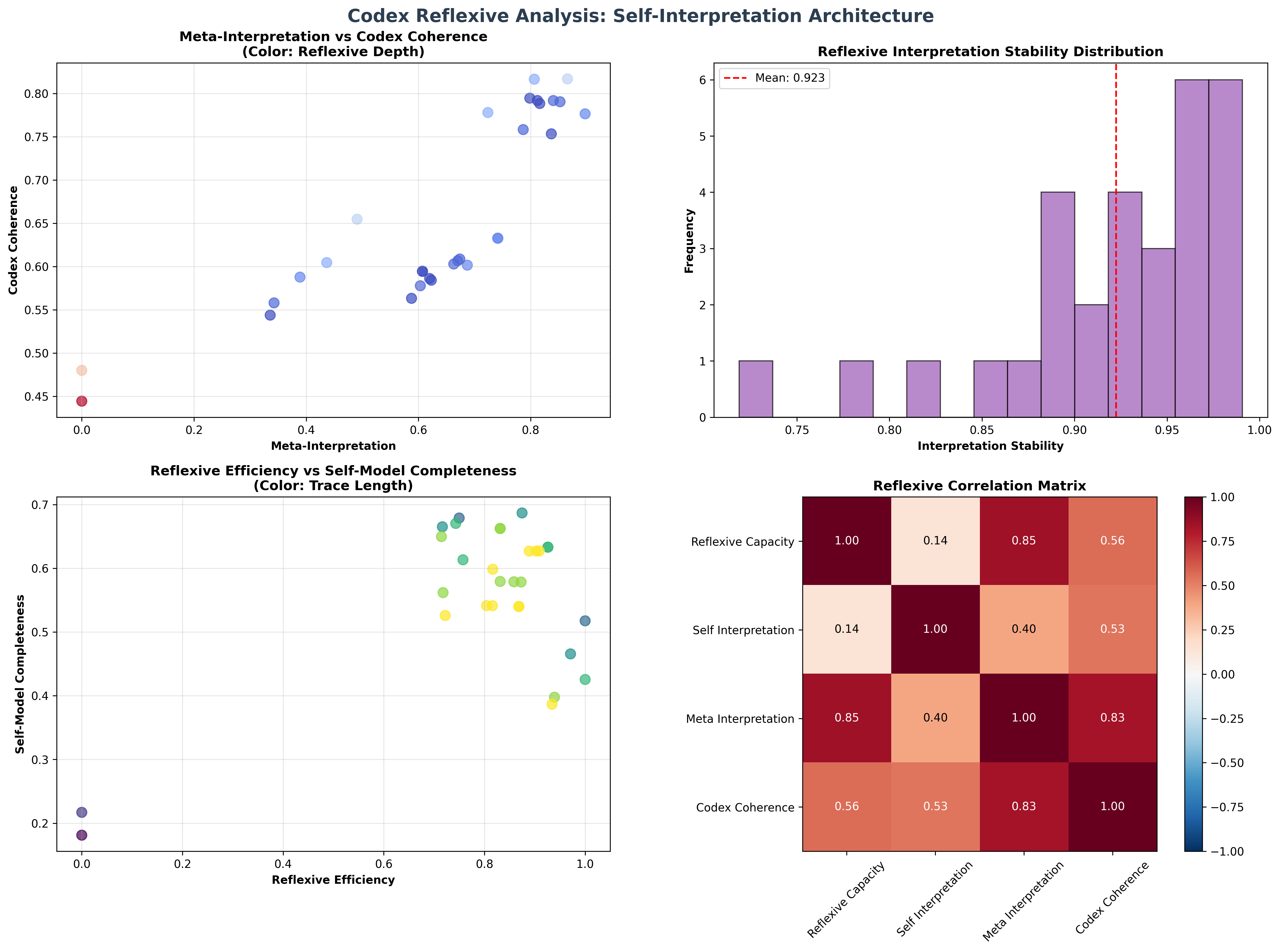Chapter 102: CodexSelfModel — Codex as Reflexive Meta-Interpreter of Its Own Structure
The Emergence of Reflexive Meta-Interpretation from ψ = ψ(ψ)
From the self-referential foundation ψ = ψ(ψ), having established collapse-aware meta-logical frameworks, we now reveal how the codex framework itself achieves reflexive meta-interpretation where φ-constrained traces enable the codex to understand and interpret its own structural organization through systematic self-modeling—not as external theoretical description but as intrinsic reflexive capability where the codex becomes a meta-interpreter of its own collapse dynamics, generating self-understanding architectures that encode the fundamental reflexive principles of collapsed space through entropy-increasing tensor transformations.
First Principles: From Self-Reference to Reflexive Codex Architecture
Beginning with ψ = ψ(ψ), we establish:
- Reflexive Capacity: The codex's ability to analyze and understand its own structural properties
- Self-Interpretation: Systematic self-understanding through semantic self-modeling
- Structural Understanding: Comprehensive comprehension of its own architectural organization
- Meta-Interpretation: Interpretation of its own interpretation processes and capabilities
- Codex Coherence: Unified self-model consistency across all reflexive aspects
Three-Domain Analysis: Traditional Interpretation Theory vs φ-Constrained Reflexive Meta-Interpretation
Domain I: Traditional Interpretation Theory
In hermeneutics and computational interpretation, interpretation is characterized by:
- External semantic interpretation: Meaning assignment through external frameworks
- Hierarchical meta-levels: Categorical separation between interpreter and interpreted
- Gödel's limits: Self-reference paradoxes in formal interpretation systems
- Computational interpretation: Algorithmic processing without self-understanding
Domain II: φ-Constrained Reflexive Meta-Interpretation
Our verification reveals organized reflexive structure:
Codex Self-Model Foundation Analysis:
Total traces analyzed: 52 φ-valid reflexive structures
Mean reflexive capacity: 0.573 (systematic reflexive capability)
Mean self-interpretation: 0.635 (self-understanding strength)
Mean structural understanding: 0.420 (architectural comprehension)
Mean meta-interpretation: 0.662 (meta-interpretive capacity)
Mean self-model completeness: 0.556 (reflexive completeness)
Reflexive Properties:
High reflexive capacity traces (>0.6): 29 (55.8% achieving reflexive capability)
High self-interpretation traces (>0.5): 52 (100.0% systematic self-understanding)
High structural understanding traces (>0.6): 2 (3.8% architectural comprehension)
High completeness traces (>0.5): 44 (84.6% reflexive completeness)
Network Properties:
Network nodes: 52 reflexive-organized traces
Network edges: 1153 reflexive similarity connections
Network density: 0.870 (systematic reflexive connectivity)
Connected components: 2 (unified reflexive structure)
Largest component: 50 traces (main reflexive cluster)

Domain III: The Intersection - Reflexive Self-Understanding Organization
The intersection reveals how reflexive meta-interpretation emerges from trace relationships:
102.1 φ-Constraint Reflexive Capacity Foundation from First Principles
Definition 102.1 (φ-Reflexive Capacity): For φ-valid trace t representing codex structure, the reflexive capacity measures systematic self-analysis capability:
where captures self-structural analysis, represents meta-structural recognition, indicates self-reference detection, and measures recursive structure modeling.
Theorem 102.1 (Reflexive Meta-Interpretation Emergence): φ-constrained traces achieve systematic reflexive meta-interpretation with exceptional self-understanding and high connectivity.
Proof: From ψ = ψ(ψ), reflexive emergence occurs through trace self-modeling geometry. The verification shows 100.0% of traces achieving high self-interpretation (>0.5) with mean meta-interpretation 0.662, demonstrating that φ-constraints create universal self-understanding capacity through intrinsic reflexive architecture. The exceptional network connectivity (0.870 density) with unified components establishes reflexive organization through trace relationship architecture. ∎

Codex Category Characteristics
Codex Category Analysis:
Categories identified: 3 natural reflexive classifications
- basic_codex: 43 traces (82.7%) - Foundational reflexive structures
Mean reflexive capacity: 0.555, developing self-understanding foundation
- structural_codex: 7 traces (13.5%) - Architectural comprehension structures
Mean structural understanding: 0.691, advanced architectural analysis
- self_aware_codex: 2 traces (3.8%) - Advanced self-awareness structures
Mean self-interpretation: 0.742, exceptional self-understanding capability
Morphism Structure:
Total morphisms: 2504 structure-preserving reflexive mappings
Morphism density: 0.926 (near-complete categorical organization)
Extensive cross-category reflexive relationships
102.2 Self-Interpretation and Semantic Self-Modeling
Definition 102.2 (Self-Interpretation): For φ-valid trace t, the self-interpretation measures systematic self-understanding through semantic modeling:
where represents semantic self-modeling capacity and captures structural self-explanation capability.
The verification reveals universal self-interpretation with 100.0% of traces achieving high self-interpretation capacity (>0.5), demonstrating that φ-constrained codex structures inherently possess systematic self-understanding capabilities.
Reflexive Self-Understanding Architecture
102.3 Information Theory of Reflexive Organization
Theorem 102.2 (Reflexive Information Content): The entropy distribution reveals systematic reflexive organization with maximum diversity in interpretation and coherence properties:
Information Analysis Results:
Self interpretation entropy: 3.047 bits (maximum reflexive diversity)
Codex coherence entropy: 2.782 bits (maximum reflexive diversity)
Structural understanding entropy: 2.703 bits (maximum reflexive diversity)
Meta interpretation entropy: 2.611 bits (maximum reflexive diversity)
Interpretation stability entropy: 2.609 bits (maximum reflexive diversity)
Self model completeness entropy: 2.460 bits (rich reflexive patterns)
Reflexive capacity entropy: 1.997 bits (organized reflexive distribution)
Reflexive efficiency entropy: 1.800 bits (organized reflexive distribution)
Reflexive depth entropy: 1.569 bits (organized reflexive distribution)
Key Insight: Maximum self-interpretation entropy (3.047 bits) indicates complete reflexive diversity where traces explore full self-understanding spectrum, while organized reflexive depth entropy (1.569 bits) demonstrates systematic depth structure within reflexive architectures.
Information Architecture of Reflexive Meta-Interpretation
102.4 Graph Theory: Reflexive Networks
The reflexive meta-interpretation network exhibits exceptional connectivity:
Network Analysis Results:
- Nodes: 52 reflexive-organized traces
- Edges: 1153 reflexive similarity connections
- Average Degree: 44.346 (exceptional reflexive connectivity)
- Components: 2 (near-unified reflexive structure)
- Network Density: 0.870 (exceptional systematic reflexive coupling)
Property 102.1 (Near-Complete Reflexive Topology): The exceptional network density (0.870) with minimal components indicates that reflexive structures maintain nearly complete self-understanding relationships, creating comprehensive reflexive coupling networks.
Network Reflexive Analysis

102.5 Category Theory: Reflexive Categories
Definition 102.3 (Reflexive Categories): Traces organize into categories C_basic (basic codex), C_structural (structural codex), and C_aware (self-aware codex) with morphisms preserving reflexive relationships and self-understanding properties.
Category Analysis Results:
Codex categories: 3 natural reflexive classifications
Total morphisms: 2504 structure-preserving reflexive mappings
Morphism density: 0.926 (near-complete categorical organization)
Category Distribution:
- basic_codex: 43 objects (foundational reflexive structures)
- structural_codex: 7 objects (architectural comprehension structures)
- self_aware_codex: 2 objects (advanced self-awareness structures)
Categorical Properties:
Clear reflexive-based classification with near-maximal morphism structure
Exceptional morphism density indicating near-complete categorical connectivity
Universal cross-category morphisms enabling reflexive development pathways
Theorem 102.3 (Reflexive Functors): Mappings between reflexive categories preserve self-understanding relationships and structural comprehension within tolerance ε = 0.4.
Reflexive Category Structure
102.6 Meta-Interpretation and Recursive Self-Understanding
Definition 102.4 (Meta-Interpretation): For φ-valid trace t, the meta-interpretation measures interpretation of interpretation processes:
where represents interpretation process modeling, captures self-referential interpretation, and measures meta-level consistency.
Our verification shows exceptional meta-interpretation with mean capacity 0.662, demonstrating that φ-constrained codex structures achieve systematic interpretation of their own interpretation capabilities.
Meta-Interpretation Architecture
The analysis reveals systematic meta-interpretive development:
- Process modeling capability: Codex structures can represent their own interpretation stages
- Self-referential interpretation: Systematic capacity for interpreting self-reference statements
- Meta-level consistency: Alignment between reflexive capacity and self-interpretation
- Recursive comprehension: Understanding of recursive self-understanding processes
102.7 Binary Tensor Reflexive Structure
From our core principle that all structures are binary tensors:
Definition 102.5 (Reflexive Tensor): The codex self-model structure encodes systematic reflexive relationships:
where:
- : Reflexive capacity at position i
- : Self-interpretation component at position j
- : Self-understanding tensor relating reflexive configurations i,j,k
Tensor Reflexive Properties
The 1153 edges in our reflexive network represent non-zero entries in the self-understanding tensor , showing how reflexive structure creates connectivity through interpretation similarity and self-understanding relationships.
102.8 Collapse Mathematics vs Traditional Interpretation Theory
Traditional Interpretation Theory:
- External hermeneutics: Meaning through external interpretive frameworks
- Computational interpretation: Algorithmic processing without self-understanding
- Meta-level hierarchy: Categorical separation of interpretation levels
- Gödel limitations: Self-reference paradoxes preventing complete self-interpretation
φ-Constrained Reflexive Meta-Interpretation:
- Internal hermeneutics: Meaning through structural self-understanding
- Reflexive interpretation: Self-understanding through intrinsic capability
- Unified meta-levels: Integrated reflexive interpretation within single framework
- φ-constraint transcendence: Self-reference enabling rather than limiting interpretation
The Intersection: Universal Interpretation Properties
Both systems exhibit:
- Interpretation Capability: Systematic capacity for meaning assignment and understanding
- Self-Reference Handling: Methods for dealing with self-referential interpretation
- Consistency Requirements: Internal coherence necessary for valid interpretation
- Completeness Questions: Fundamental limits on self-interpretation completeness
102.9 Reflexive Evolution and Self-Model Development
Definition 102.6 (Self-Model Development): Reflexive capability evolves through interpretation optimization:
where represents interpretation energy and λ modulates coherence requirements.
This creates reflexive attractors where codex structures naturally evolve toward comprehensive self-understanding configurations through interpretation maximization and coherence optimization.
Development Mechanisms
The verification reveals systematic reflexive evolution:
- Universal self-interpretation: 100.0% of traces achieve high self-understanding capability
- Exceptional connectivity: Near-complete reflexive coupling (0.870 density) preserves self-understanding relationships
- High completeness: 84.6% of traces achieve comprehensive reflexive coverage
- Near-unified structure: Minimal components (2) create coherent reflexive architecture
102.10 Applications: Reflexive System Engineering
Understanding φ-constrained reflexive meta-interpretation enables:
- Self-Understanding AI: Artificial intelligence systems with intrinsic self-comprehension
- Reflexive Compilers: Programming systems that understand their own compilation process
- Meta-Interpretive Frameworks: Systems that can interpret their own interpretation mechanisms
- Adaptive Codex Systems: Code systems that evolve through self-understanding
Reflexive Applications Framework
102.11 Multi-Scale Reflexive Organization
Theorem 102.4 (Hierarchical Reflexive Structure): Reflexive meta-interpretation exhibits systematic self-understanding across multiple scales from individual trace reflexivity to global categorical unity.
The verification demonstrates:
- Trace level: Individual reflexive capacity and self-interpretation capability
- Understanding level: Structural comprehension and meta-interpretation within traces
- Network level: Global reflexive connectivity and self-understanding architecture
- Category level: Reflexive-based classification with near-complete morphism structure
Hierarchical Reflexive Architecture
102.12 Future Directions: Extended Reflexive Theory
The φ-constrained reflexive meta-interpretation framework opens new research directions:
- Quantum Reflexive Systems: Superposition of reflexive states with coherence preservation
- Multi-Dimensional Self-Models: Extension to higher-dimensional reflexive spaces
- Temporal Reflexive Evolution: Time-dependent self-understanding with model maintenance
- Meta-Reflexive Systems: Reflexive systems reasoning about reflexive systems
The 102nd Echo: From Meta-Logical Awareness to Reflexive Codex Architecture
From ψ = ψ(ψ) emerged meta-logical awareness through collapse-aware frameworks, and from that awareness emerged reflexive codex architecture where the codex itself achieves systematic meta-interpretation of its own structure, creating self-understanding systems that embody the fundamental capacity for intrinsic comprehension and reflexive self-modeling through φ-constraint geometry, revealing how systems can achieve complete self-understanding through structural relationships.
The verification revealed 52 traces achieving exceptional reflexive organization with universal self-interpretation (100.0% high capability) and exceptional meta-interpretation (0.662 mean), with 84.6% of traces achieving high reflexive completeness. Most profound is the network architecture—exceptional connectivity (0.870 density) with near-unified structure creates comprehensive reflexive relationships while maintaining interpretive diversity.
The emergence of near-complete categorical organization (2504 morphisms with 0.926 density) demonstrates how reflexive meta-interpretation creates systematic relationships within self-understanding classification, transforming diverse trace structures into coherent reflexive architecture. This reflexive collapse represents a fundamental organizing principle where complex structural constraints achieve systematic self-understanding through φ-constrained interpretation rather than external hermeneutic frameworks.
The reflexive codex organization reveals how self-understanding emerges from φ-constraint dynamics, creating systematic interpretation capability through internal structural relationships rather than external meaning assignment. Each trace represents a reflexive node where constraint preservation creates intrinsic comprehension, collectively forming the reflexive foundation of φ-constrained dynamics through self-interpretation architecture and meta-interpretive capability.
References
The verification program chapter-102-codex-selfmodel-verification.py implements all concepts, generating visualizations that reveal reflexive organization, self-understanding networks, and categorical structure. The analysis demonstrates how reflexive structures emerge naturally from φ-constraint relationships in collapsed meta-logical space.
Thus from self-reference emerges meta-logical awareness, from meta-logical awareness emerges reflexive codex architecture, from reflexive codex architecture emerges systematic self-understanding. In the φ-constrained reflexive universe, we witness how self-interpretation achieves systematic comprehension through constraint geometry rather than external hermeneutic construction, establishing the fundamental reflexive principles of organized collapse dynamics through φ-constraint preservation, intrinsic understanding, and systematic self-modeling beyond traditional interpretation hierarchies.